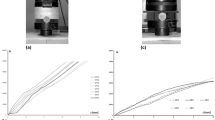Abstract
In the field of Built Heritage Restoration, engineers have to work with old structures made of poorly preserved timber elements. The assessment of timber elements and connections is a major issue for engineers involved in a restoration project. Before thinking about any intervention techniques, engineers have to properly understand how the carpentry connections fail, which parameters influence the failure modes (e.g. geometry of the joint, mechanical properties of the wood) and how the internal forces are distributed into the joint to finally figure out how to design the traditional carpentry connections. The present paper aims at raising those questions focusing on the Single Step Joint (SSJ) design. Even if this common joint between the rafter and the tie beam is geometrically simple, one may pick up three SSJ families from the past till today: the Geometrical Configuration Ideal Design, the Geometrical Configuration Perpendicular to the Tie Beam and the Geometrical Configuration Perpendicular to the Rafter. The first one is more recent because its geometry requires accurate timber cutting, using new technologies (e.g. Computer Numerical Control). For each one, some general design rules about the SSJ geometrical parameters are defined by some European standards (e.g. Eurocode 5 in Design of timber structures—part 1‐1: general—common rules and rules for buildings. CEN, European Standardisation Institute, Brussels, 8) or authors (e.g. Siem and Jorissen in Shatis’15: 3rd international conference on structural health assessment of timber structure, vol 1. Wroclaw, Poland, 9–11 Sept 2015, 11), but no detail is available on how to design this connection in order to prevent the shear crack at the heel depth in the tie beam, or the compressive crushing at the front-notch surface. Hence the design rules and the emergence of failure modes must be defined according to the SSJ geometrical parameters. In order to check the design equations and the failure modes, lab tests on the three SSJ families have been carried out, modifying the heel depth, the shear length and the inclination of the rafter.












Similar content being viewed by others
References
Yeomans D (2003) The repair of historic timber structures. Thomas Telford Ltd, London
Oslet G (1890) Traité de charpente en bois. Encyclopédie théorique & pratique des connaissances civiles et militaires. Partie Civile, Cours de construction, Quatrième partie—Edited by Chairgrasse H. Fils, Paris, France. Digital reproduction. http://gallica.bnf.fr/ark:/12148/bpt6k872975z.r=Oslet,+Gustave.langFR
Heimeshoff B, Köhler N (1989) Untersuchung über das Tragverhalten von zimmermannsmässigen Holzverbindungen. Forschungsbericht. Lehrstuhl für Baukonstruktion und Holzbau Technische Universität München, Germany, December 1989
Görlacher R, Kromer M (1991) Tragfähigkeit von Versatzanschlüssen in historischen Holzkonstruktionen. Bruderverlag, Karlsruhe, Germany, Edited by Bauen Mit Holz, March 1991
Parisi MA, Piazza M (2000) Mechanics of plain and retrofitted traditional timber connections. J Struct Eng: ASCE 126(12):1395–1403
Munafò P, Stazi F, Tassi C, Davi F (2015) Experimentation on historic timber trusses to identify repair techniques compliant with the original structural-constructive conception. Constr Build Mater 87:54–66
Sobra K, de Rijk R, Aktas YD, Avez C, Burawska I, Branco JM (2015) Experimental and analytical assessment of the capacity of traditional single notch joints and impact of retrofitting by self-tapping screws. In: Proceedings of the 2nd international conference on historic earthquake-resistant timber frames in the mediterranean region, H.Ea.R.T.2015, LNEC Lisbon, Portugal, 2–4 Dec 2015
Eurocode 5, NBN EN 1995-1-1 (2004) Design of timber structures—part 1‐1: general—common rules and rules for buildings. CEN, European Standardisation Institute, Brussels
DIN 1052:2004-08, Deutsche Norm (2004) Design of timber structures—general rules and rules for buildings. DIN Deutsches Institut für Normung e. V., Praxishandbouch Holzbau
SIA 265:2012, Swiss Norm SN505:265 (2012) Bâtiment génie civil - Construction en bois. Société suisse des ingénieurs et des architectes SIA, Swiss Standardisation Institute, Zurich
Siem J, Jorissen A (2015) Can traditional carpentry joints be assessed and designed using modern standards? Structural health assessment of timber structures. In: Shatis’15: 3rd international conference on structural health assessment of timber structure, volume 1, Edited by Jerzy Jansienko, Tomasz Nowak. Wroclaw, Poland, 9–11 Sept 2015
Bocquet J-F (2015) Les assemblages de charpentes traditionnelles dans le futur contexte réglementaire. Eurocode 5: conception et calcul des structures en bois—Sous-partie: assemblage. Formation ENSTIB. Université de Lorraine, France
Aira JR, Descamps T, Van Parys L, Léoskool L (2015) Study of stress distribution and stress concentration factor in notched wood pieces with cohesive surfaces. Eur J Wood Wood Prod 73(3):325–334
Villar JR, Guaita M, Vidal P, Arriaga F (2006) Analysis of the stress state at the cogging joint in timber structures. Biosyst Eng 96(1):79–90
Thibaut K, Colson V, Lecomte H, Claessens H (2007) Etat des lieux et perspectives du pin sylvestre en wallonie. Forêt wallone, n°87, mars/avril 2007. https://orbi.ulg.ac.be/bitstream/2268/21377/1/FW87_7-19_2007.pdf
Sobra K, Branco JM (2015) Short term scientific mission report: experimental evaluation of dovetail joints. Assessment, reinforcement and monitoring of timber structures. STSM COST Action FP1101. http://www.costfp1101.eu/images/STSM/STSM_report_SOBRA.pdf
Acknowledgements
This work was financed by FEDER funds through the Competitivity Factors Operational Programme—COMPETE and by national funds through FCT—Foundation for Science and Technology within the scope of the project PTDC/EPH-PAT/2401/2014. This work was partly financed in the framework of the Portuguese Public Procurement Code, LOTE 3ES2—Escola Secundária de Loulé e Olhão.
Author information
Authors and Affiliations
Corresponding author
Rights and permissions
About this article
Cite this article
Verbist, M., Branco, J.M., Poletti, E. et al. Single Step Joint: overview of European standardized approaches and experimentations. Mater Struct 50, 161 (2017). https://doi.org/10.1617/s11527-017-1028-4
Received:
Accepted:
Published:
DOI: https://doi.org/10.1617/s11527-017-1028-4




